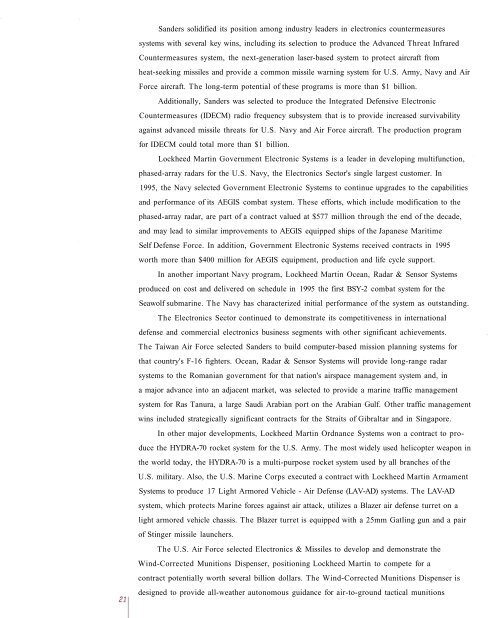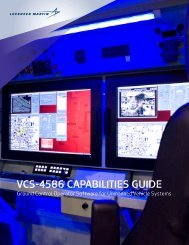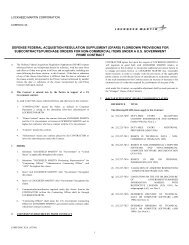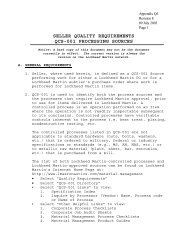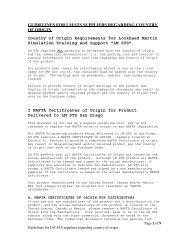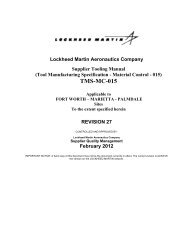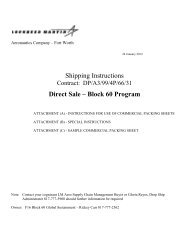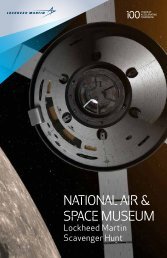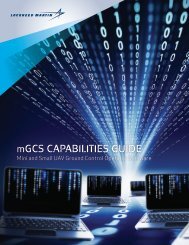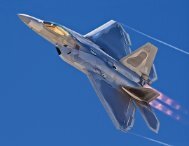1995 Annual Report - Lockheed Martin
1995 Annual Report - Lockheed Martin
1995 Annual Report - Lockheed Martin
Create successful ePaper yourself
Turn your PDF publications into a flip-book with our unique Google optimized e-Paper software.
Sanders solidified its position among industry leaders in electronics countermeasuressystems with several key wins, including its selection to produce the Advanced Threat InfraredCountermeasures system, the next-generation laser-based system to protect aircraft fromheat-seeking missiles and provide a common missile warning system for U.S. Army, Navy and AirForce aircraft. The long-term potential of these programs is more than $1 billion.Additionally, Sanders was selected to produce the Integrated Defensive ElectronicCountermeasures (IDECM) radio frequency subsystem that is to provide increased survivabilityagainst advanced missile threats for U.S. Navy and Air Force aircraft. The production programfor IDECM could total more than $1 billion.<strong>Lockheed</strong> <strong>Martin</strong> Government Electronic Systems is a leader in developing multifunction,phased-array radars for the U.S. Navy, the Electronics Sector's single largest customer. In<strong>1995</strong>, the Navy selected Government Electronic Systems to continue upgrades to the capabilitiesand performance of its AEGIS combat system. These efforts, which include modification to thephased-array radar, are part of a contract valued at $577 million through the end of the decade,and may lead to similar improvements to AEGIS equipped ships of the Japanese MaritimeSelf Defense Force. In addition, Government Electronic Systems received contracts in <strong>1995</strong>worth more than $400 million for AEGIS equipment, production and life cycle support.In another important Navy program, <strong>Lockheed</strong> <strong>Martin</strong> Ocean, Radar & Sensor Systemsproduced on cost and delivered on schedule in <strong>1995</strong> the first BSY-2 combat system for theSeawolf submarine. The Navy has characterized initial performance of the system as outstanding.The Electronics Sector continued to demonstrate its competitiveness in internationaldefense and commercial electronics business segments with other significant achievements.The Taiwan Air Force selected Sanders to build computer-based mission planning systems forthat country's F-16 fighters. Ocean, Radar & Sensor Systems will provide long-range radarsystems to the Romanian government for that nation's airspace management system and, ina major advance into an adjacent market, was selected to provide a marine traffic managementsystem for Ras Tanura, a large Saudi Arabian port on the Arabian Gulf. Other traffic managementwins included strategically significant contracts for the Straits of Gibraltar and in Singapore.In other major developments, <strong>Lockheed</strong> <strong>Martin</strong> Ordnance Systems won a contract to producethe HYDRA-70 rocket system for the U.S. Army. The most widely used helicopter weapon inthe world today, the HYDRA-70 is a multi-purpose rocket system used by all branches of theU.S. military. Also, the U.S. Marine Corps executed a contract with <strong>Lockheed</strong> <strong>Martin</strong> ArmamentSystems to produce 17 Light Armored Vehicle - Air Defense (LAV-AD) systems. The LAV-ADsystem, which protects Marine forces against air attack, utilizes a Blazer air defense turret on alight armored vehicle chassis. The Blazer turret is equipped with a 25mm Gatling gun and a pairof Stinger missile launchers.The U.S. Air Force selected Electronics & Missiles to develop and demonstrate theWind-Corrected Munitions Dispenser, positioning <strong>Lockheed</strong> <strong>Martin</strong> to compete for acontract potentially worth several billion dollars. The Wind-Corrected Munitions Dispenser isdesigned to provide all-weather autonomous guidance for air-to-ground tactical munitions


